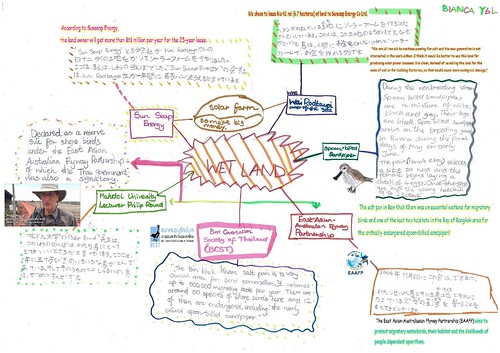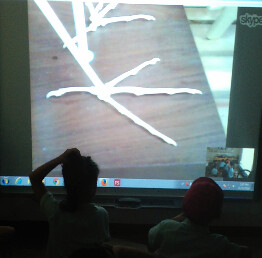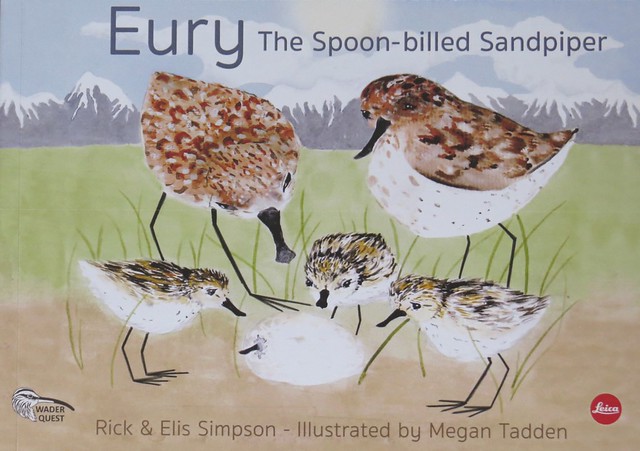Hiroshi Tomida, Manko Waterbird and Wetland Center, Japan
Ewen Mcleish, St. Andrews International School Bangkok, Thailand
Kiyomi Morita, St. Andrews International School Bangkok, Thailand
Introduction
As can be seen already, the number of migratory shorebirds is in rapid decline, posing a serious threat to biodiversity. Expanding coastal development has caused much damage. In addition, climate change will continue to alter intertidal wetland ecosystems. Among the world’s nine flyways, the East Asian-Australasian Flyway is the most crucially threatened. A recent report predicted that 90% of sand beach in Japan will disappear due to rising sea levels. Sustainability education programmes that focus on environment, society and the economy are an essential tool for wildlife conservation and our future.
‘Sustainability Week’ at St. Andrews International School Bangkok
The mission of St. Andrews International School Bangkok (STA) is to “provide an inclusive, international education in a safe, happy, supportive and stimulating environment where all the needs of the individual learner are met. Students are inspired to be the best they can be, enabling them to become responsible global citizens.”
As well as Literacy lessons in English, students are provided with First Language programmes in Thai, German, Japanese and French. These programmes follow the topics which the children study in their mainstream classes, as well as the language curricula of their home countries. The First Language Japanese programme is designed to focus on language and cultural development, and to cultivate awareness of global citizenship. It also aims to form and develop the students’ Japanese identity.
In February 2016, a ‘Sustainability Working Group’ was set up and run by Mr. Ewen Mcleish, a primary teacher with an interest in Education for Sustainability. The group’s purpose was to begin to develop sustainability and education at STA. The UK’s ECO-School criteria were discussed during several meetings. The United Nations definition of sustainability was also reviewed. The working group searched for a starting point for developing sustainability further at STA and decided to set up their first Sustainability Week in November of this year, with the following objectives:
- To raise the profile of issues of sustainability and the issues involved within the school.
- To reflect on the meaning of the word sustainability, and what it means for how we live our lives.
- To give the students a chance to be responsible for their actions.

Mr. Ewen Mcleish introduced students for the Spoon-billed Sandpiper, and its conservation.
As an active and enthusiastic member of the working group, Ms Kiyomi Morita, a Japanese teacher, visited Manko Waterbird and Wetland Centre in Okinawa Island, Japan, during her school break. It was there that Morita met Mr. Hiroshi Tomida, with the intention of seeking out topics and activities for the forthcoming Sustainability Week.
Learning about the Spoon-Billed Sandpiper during Japanese Lessons
The special Sustainability Week was organized differently across the school. Teachers planned a variety of lessons for the students. Morita started thinking about a series of lessons about wetland inhabitants for Year 6 students (10-11 years old) and the ecology of birds for Year 4 students (8-9 years old). Via email, Morita shared with Tomida, her ideas regarding Spoon-billed Sandpipers in her Japanese lessons.
Following their meeting and ensuing discussions, Tomida decided to send Morita an article about the threat to Spoon-billed Sandpipers visiting Thailand, due to the production of solar farms. The Spoon-billed Sandpiper is currently one of the most threatened species in the world. Whilst this is good enough reason to educate people about their plight, it is important to also consider the ‘bigger picture’.
During the summertime, the birds breed within a narrow band of the Arctic tundra, in northeastern Russia. During the winter, they migrate to the more sub-tropical areas, such as Thailand, Myanmar and Bangladesh, stopping in Korea, China and Japan. The Spoon-billed Sandpiper can therefore be seen to connect Thailand and Japan. Its story is relevant to STA’s Japanese students due its faltering numbers in Japan. Additionally, as can be seen from the previously mentioned newspaper article, the Spoon-billed Sandpiper’s habitat in Thailand is also under threat in Khok Kham [EAAF122], just 35km south of STA School. Due to the close proximity of this problem, there is potential for all of the students at STA School to see its relevance. The tricky relationship between one sustainability goal (clean energy) and another (preservation of life on land) can therefore be discussed in a pertinent context. The newspaper article was of huge inspiration for Morita. With the support of Mcleish, she decided to integrate this topic into her lessons for Sustainability Week.
Morita explains the process of how the students developed their interests and became motivated learners.

Students draw mind map based on information about habitat management issue in Khok Kham.
Case Study 1: Year 6 Lessons: Looking on the Bright Side and Creating New Ideas
The Year 6 students were asked to read the newspaper article and draw a mind map so that they could see clearly what the problem was. Morita made use of a video, which showed two viewpoints: that of the Thai Khok Kham residents, and that of a bird specialist. This helped the students to develop their mind maps and analyze the issue. The students then got a sense of the dilemma between the planned solar farms and bird conservation in Khok Kham. It seemed to be hard for them to fully understand the complexity of the issues involved. However a later Skype lesson with Tomida clarified things.
This interactive lecture greatly stirred the students. As a consequence they wanted to do something practical to help the birds, and they subsequently contacted the School Council, run by Mcleish. The School Council was enthusiastic about helping out, and Mcleish introduced the big project to the rest of the primary students during assembly. Mcleish informed the children of the story through a slideshow produced by the Bird Conservation Society of Thailand (BCST) which is also active in campaigning for the Spoon-billed Sandpiper. The students seemed to take it for granted that it was humans’ (and therefore their) responsibility to save the endangered birds.

Students explained similarity and difference of painted skeleton of Archaeopteryx. and Explanation for evolutionary trace to using real skeleton specimen.
Case study 2: Year 4 Lessons: Evolution from Dinosaurs to Birds
Morita and Tomida continued discussing further details regarding tasks for the Year 4 students. Morita’s starting point was an article entitled, ‘Dinosaur Footprints Found on Western Australian Beach.’ Morita was already aware that children love to learn about dinosaurs. Henceforth, she connected birds to the students’ previous learning about them. Next, she showed the students a couple of videos to introduce different species of birds. The children watched these carefully, writing down as many bird names as possible.
After a quick review, Morita provided another video about dinosaur evolution so the students could think about the differences and the similarities between birds and dinosaurs. The Year 4s created posters showing what they learned.
Tomida initiated a task: the students compared and contrasted birds and dinosaurs using a diagram of an Archaeopteryx skeleton. Finally, the children had special academic instruction from Tomida during Skype lessons. During this, the Year 4s were able to arrive at their own conclusions about the evolution and connections between birds and dinosaurs. Again, the children found these participatory lectures hugely inspiring and were eager to learn more about both birds and dinosaurs.
Funds Raised through the STA Japanese Craft Fair
Both Year 6 and Year 4 children were keen to do something to help the birds, and worked with the members of the School Council to organize a Japanese Craft Fair in aid of the Spoon-billed Sandpiper. This fair took place during Sustainability Week (7th to 11th November). It was a success from the perspective of all involved. All stalls were connected to the Spoon-billed Sandpipers. Sale items used recycled/recyclable materials, for example, with one stall fondly entitled ‘Dino-Zen.’ From previous learning experiences, the Year 6 students knew how to make Mini Zen Gardens. Mini Zen gardens were constructed in reused plastic boxes and included toy dinosaur eggs. These would hatch into ‘real’ dinosaurs if placed in water!
One stall focused on how the birds feed on kinds of small worms in the wetlands. (They are considerably good at picking them up with their spoon-shaped beaks). The students therefore made and sold ‘wormy jelly.’ Any customer could experience digging up an ‘earthworm’, in the same way as a Spoon-billed Sandpiper, for themselves!
There were also two stalls connected with breeding of the birds. Giant origami birds were made and coloured by the students; nests were made for these, along with eggs which had been decorated by children.
All members worked extremely hard in preparation for the Craft Fair, and all items sold out on the same day. It could be seen that not only were the children learning (and teaching others) about such an important, relevant issue, they were also honing their organisational and enterprising skills in the challenging process of selling their items within a short time span.
As can be seen on the school website the students raised THB 7,579 in total. This donated money will be transferred to Mr. Baz Hughes, Head of the Species Conservation Department (in the UK) as well as aviculturist Mr. Roland Digby (based in Russia) both from the Wildfowl & Wetlands Trust (WWT). The WWT is a conservation charity that saves wetlands.
After fundraising, the students created a report about their series of activities focused around the Spoon-billed Sandpiper. They will be conveying their thoughts to Tomida through an upcoming Skype lesson. It is hoped that the Craft Fair signals the beginning of a repeated educational programme on Spoon-billed Sandpipers that might further inspire sustainable education programs in the future:- a small step towards a brighter future for conservation.
Future Plans within Japanese Lessons at STA
To continue with the teaching of this topic, Morita intends to integrate it into her Japanese literacy lessons. She has discovered an organization called ‘Wader Quest‘ which has published a charming picture book about the Spoon-billed Sandpiper. Wader Quest has a long term plan to raise public awareness about this bird. Morita means to translate the book from English into Japanese in preparation of part of her next series of Japanese classes.

Story book on the Spoon-billed Sandpiper




